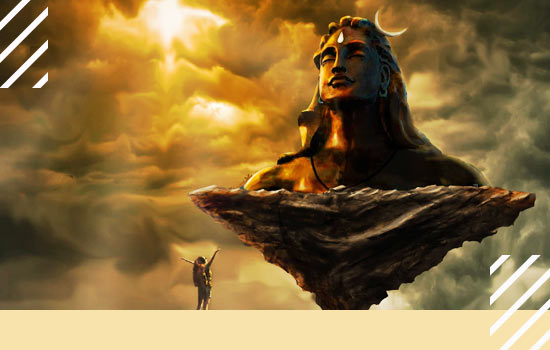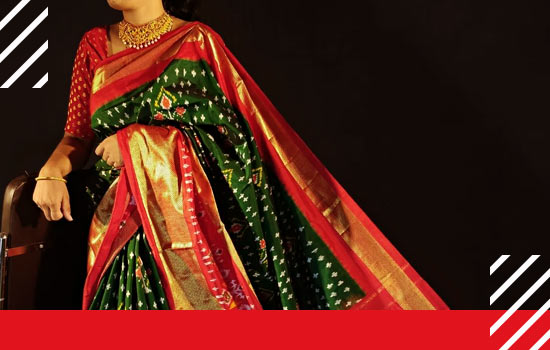Straight from ‘The Essence of Incredible India’ comes an art form that is not only rare but has its own history and is still prevalent in our country.
Can you guess?
Yes, we are talking about the ‘Kalamkari’ art coming from the state of Andhra Pradesh with its own distinctive styles.
Kalamkari is a type of either hand-painted or block printed cotton textile which is not only produced in Andhra Pradesh but also in Isfahan, Iran.
Though, there is a change in the techniques but the art still uses natural dyes that involve twenty-three steps: complex, complicated yet vibrant and beautiful.
Recommended Story – Amounee – The voice of artisans
Origin of Kalamkari –

It was known as ‘Pattachitra’ historically and has even been mentioned in the ancient Hindu, Jain, and Buddhist literature.
‘Patta’ means ‘cloth’ and ‘Chitra’ means ‘picture’ meaning paintings made on fabric and fabric scrolls.
The term ‘Kalamkari’, under the medieval Islamic rule was derived from ‘Kalam’ meaning ‘pen’ and ‘Kari’ meaning ‘craftsmanship’. It came under the limelight under the patronage of Golconda sultanate.
The term in the middle ages was also used to describe the making of cotton fabric patterned through vegetable dyes by free-hand or block-print and was produced in many regions in India.
History of Kalamkari –

It found itself as an art form in the Golconda sultanate, Hyderabad during the middle age. The Mughals who patronized this art form called the practitioners as ‘Qualamkars’ from which the term ‘Kalamkari’ actually evolved.
The ‘Pedana’ Kalamkari craft coming from Pedana near Machilipatnam in Krishna District, Andhra Pradesh evolved under the Mughal and Golconda sultanate.
The art form has been practiced by many families in Andhra Pradesh and few villages in Tamil Nadu by migrants from Telegu-speaking families have created their own livelihood since generations.
There came a time when Kalamkari declined but it found its way back and to the abroad due to its craftsmanship.
Since the 18th century, Britishers have been enjoying this art form as a decorative element for clothing.
You can spot large panels of Kalamkari depicting the episodes of Hindu Mythology and Iconography similar to that of Thangka Paintings in Buddhism.
Distinctive Styles –
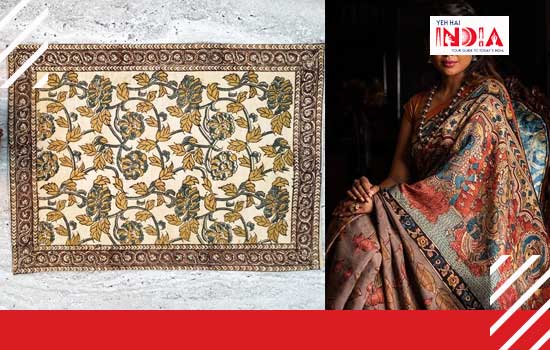
There are two distinctive styles of Kalamkari –
Srikalahasti Kalamkari –
Srikalahasti Kalamkari is a style of Kalamkari work that involved dyed hand-painting of a fabric and is produced in the Srikalahasti area in Chittoor District of Andhra Pradesh.
The origin of Kalamkari can be seen since the period of Vijayanagara Empire.
As the word ‘Kalam’ explains itself in Persian language meaning ‘pen’, this style involves using of pen for both hand drawing and colouring.
The colouring part involves usage of just natural dyes made from fruits and vegetables.
The entire process has seventeen-steps that include block making, cloth treatment, printing, washing, etc., and the end result depicts religious myths and epics stories on the fabric.
Pedana Kalamkari –
Pedana Kalamkari also known as ‘Machilipatnam’ style of Kalamkari is produced in Machilipatnam in Krishna district of Andhra Pradesh.
The style evolved under the rule of Mughal Dynasty and practiced by Golconda Sultanate. You can witness this style on textile products such as wall hangings and clothing pieces like bed sheets, curtains, saris etc.
It uses vegetable dyes which are applied onto the fabrics with the help of wooden blocks.
Technique –
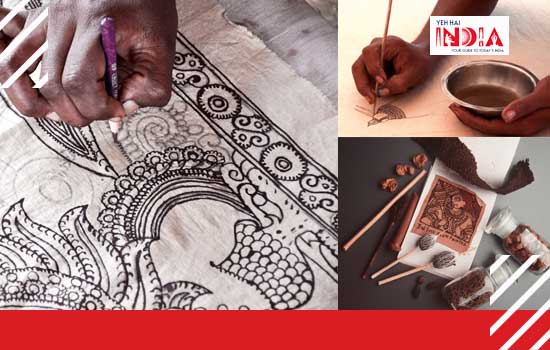
The technique starts with the first step where the Kalamkari is steeped in astringents and buffalo milk and then dried under the sun.
Once all of this is done, portions of red, black, brown, and violet of the designs are outlined with a mordant and then placed in alizarin.
The cloth is later covered except the parts that need to be dyed blue, in wax, and is immersed in Indigo dye.
The wax is scrapped off and the remaining areas are painted by hand.
For creating design contours, artisans use either bamboo or date palm stick pointed at one end with a bundle of fine hair that acts as the brush.
The brush or the pen is soaked in a mixture of jaggery and water; by applying these one by one vegetable dyes are added.
Recommended Story – 10 Astounding Art Forms of Kerala
Colour Fixing –
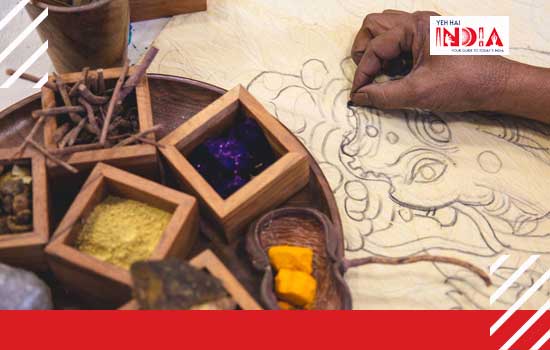
Dyes are obtained and extracted from various roots, leaves, and mineral salts of iron, copper, tin, and alum.
For the effects, cow dung, seeds, plants, and crushed flowers are used in order to obtain natural dye.
Myrobalan is used in Kalamkari for removing the odd smell of buffalo milk as it can easily fix the dye or colour of the textile while treating the fabric.
Alum on the other hand is used in making dyes as it also ensures stability of the colour in Kalamkari fabric.
Themes –

The Kalamkari art specifically depicts scenes from the Ramayana or Mahabharata.
Recent applications depict the Buddha and the Buddhist art forms. You can also witness aesthetically good figures such as musical instruments, small animals, flowers, Buddha, and Hindu symbols such as Swastika.
Modern Day –
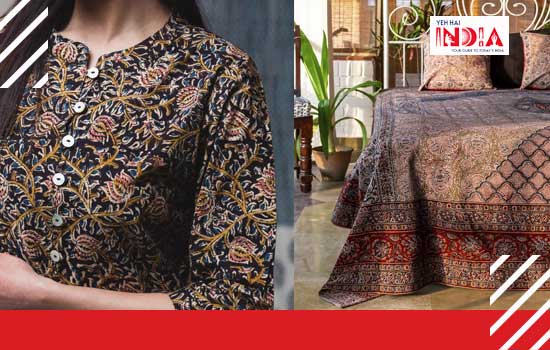
In the present times, traditional techniques have been replaced by digital techniques and these new techniques have successfully introduced the digital files of Kalamkari in many regions of Iran and India.
Printing is much easier than the traditional Kalamkari work which is evident on Silk, Cotton, Mulmul, and Synthetic sarees.
Kalamkari dupattas and blouse pieces have also gained popularity among the Indian women.
Also Read – CHAMBA RUMAAL – A Peculiar Visual Art Form




